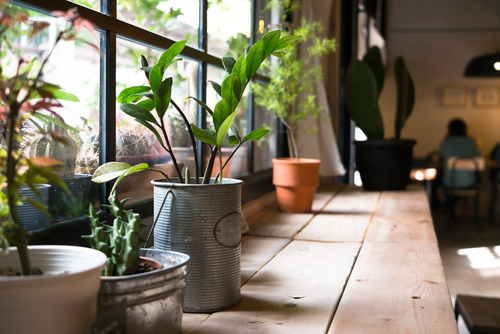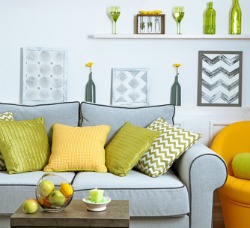If you want a blueprint for happiness at home, modern science can help provide it. As environmental psychologists study the effects of physical space on mood and emotions, neuroarchitects—a mashup of neuroscience and design—investigate how our physical surroundings influence brain processes such as stress, emotion and memory. Together, their findings suggest that the purchases we make at Home Depot or Pottery Barn can affect us in ways we never would have imagined.
Sitting pretty
Consider the matter of buying a chair. Sally Augustin, Ph.D., editor of Research Design Connections, says that psychologists studying the implications of the way we sit found that our posture influences “the rich chemical stew in our brains.” People sitting up straighter have more positive views of themselves than people slouching. Sitting in a way that allows you to take up as much room as possible leads you to feel more powerful and have a higher tolerance for risk. Even padding matters. People perched on hard chairs are much more inflexible during negotiations than those on soft seats.
 Science also explains why we’re so willing to pay more for a room with a view: It’s good medicine. A 1984 study by psychologist Roger Ulrich found that surgical patients in a Pennsylvania hospital whose windows overlooked a small stand of trees left the hospital a full day sooner, had fewer complications and required less pain medication than patients with views of a brick wall. In 2006, neuroscientist Irving Biederman of the University of Southern California discovered that there’s a part of our brains, the parahippocampal cortex, that responds to sweeping views. Rich in opiate receptors, the site releases endorphins, our feel-good hormones, when we gaze at pleasing vistas.
Science also explains why we’re so willing to pay more for a room with a view: It’s good medicine. A 1984 study by psychologist Roger Ulrich found that surgical patients in a Pennsylvania hospital whose windows overlooked a small stand of trees left the hospital a full day sooner, had fewer complications and required less pain medication than patients with views of a brick wall. In 2006, neuroscientist Irving Biederman of the University of Southern California discovered that there’s a part of our brains, the parahippocampal cortex, that responds to sweeping views. Rich in opiate receptors, the site releases endorphins, our feel-good hormones, when we gaze at pleasing vistas.
Researchers also say we’re hardwired to respond to nature because our survival as a species depended on careful observation of it. We needed to know how to respond to weather, spot predators, find refuge, farm and hunt when there was sunlight, and sleep when there was none. Roger Ulrich, who did the study of hospital-room views, has said, “When we recognize those elements today, even if we’re highly stressed or sick, our blood pressure lowers, our immune system functions better, and we feel less stressed.”
Harvard biologist Edward O. Wilson coined the term “biophilic design” to describe architecture or design that connects us with a living environment. To get a biophilic buzz, we don’t need to let goats graze in our living room. We can stay in touch with the cycle of sunlight—and our own circadian rhythms—by placing sheer curtains on our windows. Or, says Sally, even incorporating visible wood grain into our environment, through hardwood floors or unpainted maple or walnut furniture, will have a calming effect.
Happy places
 Creating what Sally calls a more “place happy” home isn’t rocket science. Or even neuroscience. But it does require us to approach buying, remodeling or decorating tweaks to our home with introspection. Architect Sarah Susanka is the author of Not So Big Solutions for Your Home. Her philosophy is that instead of focusing on square footage and traditional room plans, we think instead about what it takes to create a home that’s an expression of our authentic self. “When our houses reflect who we really are,” she says, “we end up feeling much more at home in our lives.”
Creating what Sally calls a more “place happy” home isn’t rocket science. Or even neuroscience. But it does require us to approach buying, remodeling or decorating tweaks to our home with introspection. Architect Sarah Susanka is the author of Not So Big Solutions for Your Home. Her philosophy is that instead of focusing on square footage and traditional room plans, we think instead about what it takes to create a home that’s an expression of our authentic self. “When our houses reflect who we really are,” she says, “we end up feeling much more at home in our lives.”
Sarah says her clients are often uneasy after ceding control to an interior designer. “It’s like walking onto the stage set of somebody else’s home,” she says. “It’s filled with beautiful things but it doesn’t feel like their home because these objects don’t have any meaning to them.” Sarah suggests keeping a place journal for home-improvement projects. Make notes about the places in your life that make you comfortable. Take photos and make diagrams; you might admire the beauty of a soaring greenhouse but feel diminished by the scale of the space. Supplement with pages from your favorite magazines or websites.
We've come up with eight ideas to make your home into a truly happy space. Experiment; pick and choose the ones that fit your personality.
1. Use space creatively
Make a dining room double as a library by adding bookshelves. Place area rugs beneath furniture arrangements to define areas for reading, conversation and work.
2. Bring in the house plants
Greenery helps sharpen focus, boost immunity, clear the air and lift our spirits. For a natural sleep aid, keep potted lavender in your bedroom. According to NASA, plants can remove up to 87 percent of gases like benzene and formaldehyde within 24 hours.
3. Make a breeze
Place a plant or mobile near a window or fan for soothing motion.
4. Cultivate smart messiness
For all the books on banishing clutter, décor that’s too minimalist can rob us of ways to highlight our values and interests. Decorate with travel mementos, family photos and objects that evoke happy memories.
5. Create a space of your own
We all yearn for an area of retreat. This can be a window seat or a corner of a room framed with a folding screen for quiet contemplation.
6. Have a focal point for each room
A fireplace, bay window, sculpture or potted palm tree are all good forms of visual punctuation.
7. Move Away from the walls
Place furniture in a way that lets people meander around the space, but make sure everyone’s back is protected. Create “symbolic” points of protection with standing lamps and console tables.
8. Arrange seating for conversation
Place couches and chairs in a loose circular or horseshoe arrangement.
Shelley Levitt is a freelance journalist based in Southern California and an editor at large for Live Happy.






